|
Tide Bite
October 2018, Vol. 62
|
Pygmy Seahorses – Little Fish With a Big Impact
by Graham Short
Graham is a research associate at the California Academy of Sciences, a summer resident on San Juan island, and a guest researcher at Friday Harbor Laboratories (FHL). His research interests are focused on the evolutionary relationships, taxonomy, and systematics of fishes in the Syngnathidae family, which include the seahorses, pipehorses, and seadragons. The past two summers Graham has been CT-scanning several species of seahorses, in particular the tiny pygmy seahorses, in Adam Summers’ lab to elucidate the subtle morphological characters that distinguish one species from another.
|
The family Syngnathidae is a large and diverse group of morphologically unique bony fishes, with 57 genera and 300 described predominantly small-bodied marine species of seahorses, pipefishes, pipehorses, and seadragons. The family occurs worldwide in shallow temperate to tropical waters in a range of habitats, including seagrass beds, estuaries, coral and rocky reefs, and mangroves, and are characterized by a fused jaw, extraordinary crypsis, and their unique and specialized reproductive biology. All syngnathids have male brooding structures, and some genera, such as the iconic seahorse in the genus Hippocampus, evolved true male pregnancy with complete nutrient and oxygen delivery to the developing embryos. There are 43 currently recognized species of seahorses (Lourie et al. 2016), the majority of which are comprised of medium to large species (just under an inch to 14 inches). In contrast, seven species of really tiny seahorses, the pygmy seahorses, are diminutive in size (third of an inch to half an inch: you can fit a few of them on your pinky nail with room to spare) and are morphologically distinct from the more numerous and larger species of seahorses (Figure 1).
|

Fig. 1: Hippocampus pontohi on a finger nail.
|
Apart from their extremely small size, they have a single gill opening on the back of the head (imagine having your nose on the back of your neck), whereas all other seahorses have a pair of gill openings on either side of the head, and the young are brooded within the male’s trunk rather than a pouch on the tail. Two species of dwarf seahorses are sometimes referred to as pygmy seahorses, but differ by lacking the true pygmy’s single gill opening and trunk brooding. These include the endemic Red Sea seahorse H. debelius which dwells only in soft coral, and H. zosterae, a Western Atlantic species that inhabits seagrass and other submerged vegetation.
|
|
Fundamental information on the taxonomy, systematics, ecology, and distribution of pygmy seahorses is still relatively sparse in comparison to the larger seahorse species. Within the first decade of the 21st century six new species of pygmy seahorse were officially described. Bargibant’s pygmy seahorse (Hippocampus bargibanti) was the first species of pygmy seahorse to be discovered.
In 1969 a New Caledonian scientist, Georges Bargibant, was collecting specimens of Muricella sp gorgonians for the Noumea museum and upon inspection of a specimen he happened to notice a pair of tiny seahorses. I certainly don’t blame him if he thought he'd too much kava (a South Pacific herbal intoxicant produced by locals masticating the plant root) the previous night.
Hippocampus bargibanti
resembles a miniature version of Daffy Duck (Figure 2), and has been sometimes observed congregating in relatively high numbers on one sea fan (2 to 15 individuals) in which all the males are pregnant. This might have you thinking of a Daffy Duck Lamaze child birthing convention.
|
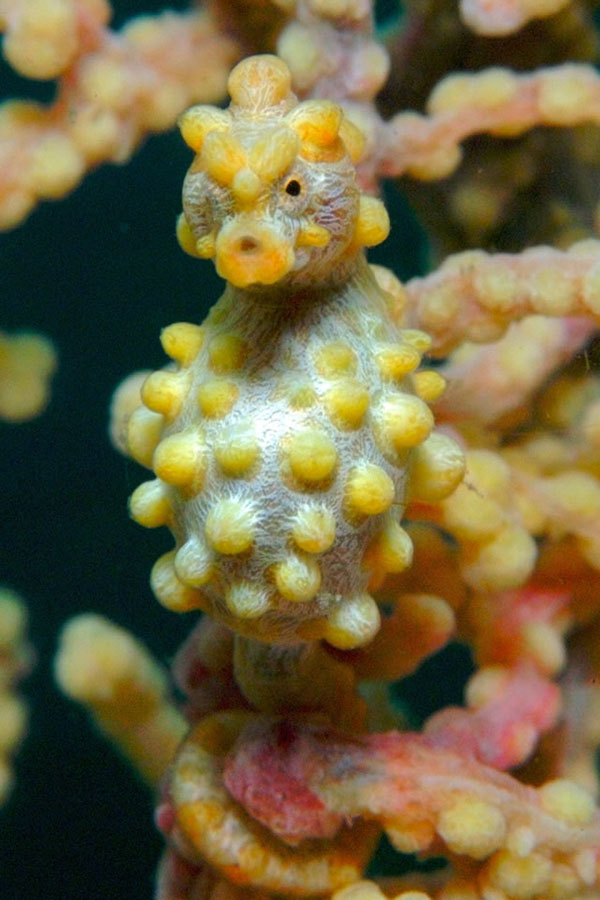
Fig. 2: Hippocampus bargibanti.
Photo credit: G. Short.
|
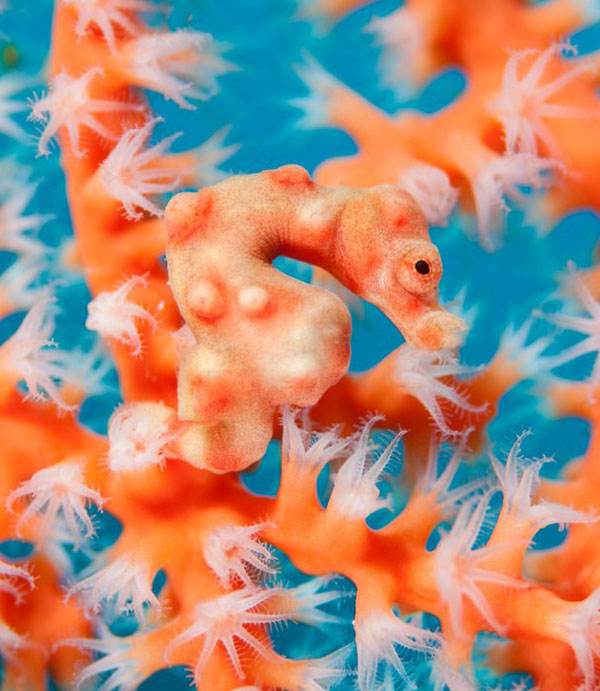
Fig. 3: Hippocampus denise.
Photo credit: R. Smith.
|
Seven pygmy seahorse species are now currently recognized and documented throughout the central Indo-Pacific, ranging from the Coral Triangle, West Pacific, NSW and QLD Australia, to central Japan:
H. bargibanti,
H. denise,
H. colemani,
H. japapigu,
H. pontohi,
H. satomiae, and
H. waleananus.
Hippocampus denise, like
H. bargibanti, is a habitat specialist living in an obligate relationship with deep-water (10-100 m) gorgonian corals, however it has been recorded from a total of ten gorgonian genera (including Acanthogorgia sp, Annella sp, Echinogorgia sp, Ellisella sp, Melithaea sp, Muricella sp, Verrucella sp, Villogorgia sp), compared to just one genus for
H. denise (Figure 3).
|
|
Hippocampus colemani,
H. japapigu, and
H. pontohi are free-living, rather than associated with gorgonian corals, and are quite active. They are most commonly found living in pairs or small groups in clumps of the calcareous alga,
Halimeda or on hydroids. (Figure 4). In the case of
H. japapigu, they are found on huge boulders with
Halimeda or hydroid growth. These three species are found within the Coral Triangle area that includes Indonesia, Papua New Guinea, Solomon Islands and Fiji, as well as Japan. They are also often found in shallower areas than the gorgonian-associated species between 3 – 20 m.
|
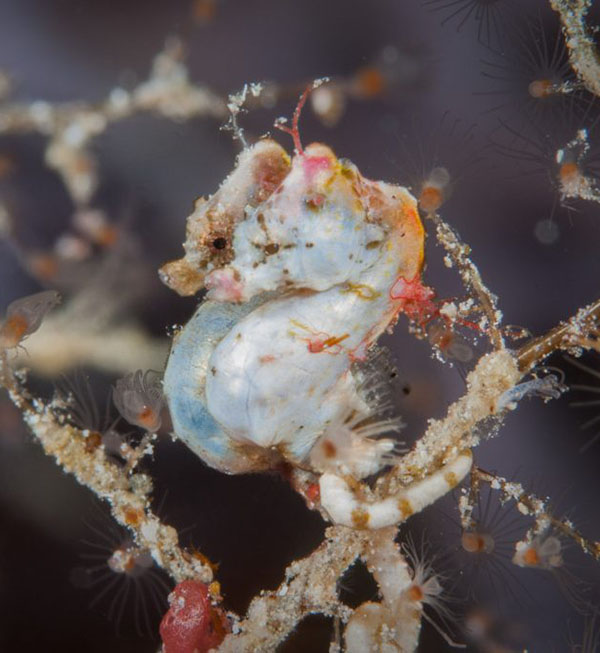
Fig. 4: Hippocampus pontohi.
Photo credit: R. Smith.
|
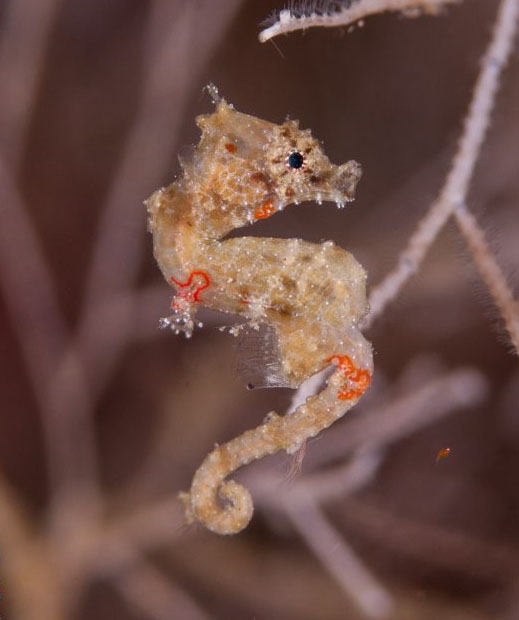
Fig. 5: Hippocampus satomiae.
Photo credit: R. Smith.
|
Satomi’s pygmy seahorse (
Hippocampus satomiae) is one of the hardest species to find as they are found on rich coral walls, are nocturnal and quite active, and is the world’s smallest seahorse, reaching a maximum total length of less than 1.4 cm (Figure 5). This species was described in 2008 and is known only from a few localities in Indonesia. Their small size and nocturnal habits probably mean they are more widely distributed than this but have just evaded detection.
|
|
Lastly, the Walea Soft Coral pygmy seahorse
(Hippocampus waleananus) is another species that lives in association with a sessile invertebrate, in this case soft corals. The stems of soft corals are more variable and larger in diameter than gorgonian stems and as a result the tail of
H. waleananus are significantly longer than those of other pygmy seahorses (Figure 6)! This pygmy seahorse is unique in being restricted to only a very small geographic area as it has been discovered only in the Tomini Gulf of central Sulawesi, Indonesia and nowhere else on the planet.
|

Fig. 6: Hippocampus waleananus.
Photo credit: R. Smith.
|
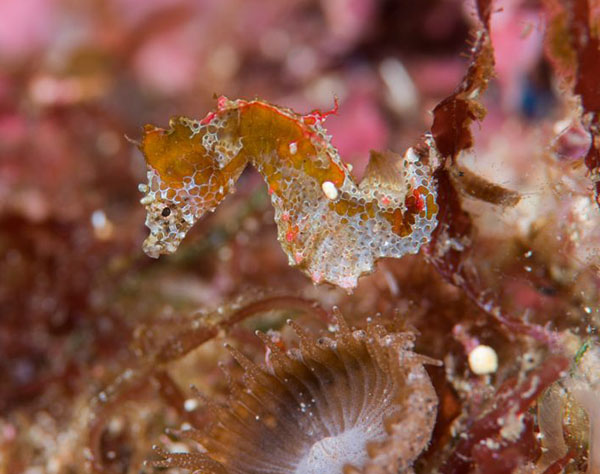
Fig. 7: Hippocampus japapigu.
Photo credit: R. Smith.
|
Systematically, there is a deep genetic split between the true pygmy seahorses and the larger species of seahorses (Hamilton et al. 2017) whereby seahorse species cluster into pygmy and non-pygmy lineages, with a notable evolutionary distance between these two groups. This split is reflected morphologically as previously mentioned by derived characters exhibited by the pygmy seahorses. In a paper recently published in Zookeys (Short et al., 2018), I presented a description of a new species of pygmy seahorse from Japan,
H. japapigu (Figure 7).
|
This species was thoroughly diagnosed by detailed micro-CT scans produced in Adam Summer’s lab with the help of Jules Chabain (Figure 8). Upon close inspection of the scans, I had a huge eureka moment and my eyes bulged out: I discovered some amazing and novel morphological characters in H. japapigu that no other seahorse possessed! High-resolution photography and radiographs would not have discerned these unusual characters, therein lies the power of CT scans. Therefore, this little and new species of pygmy seahorse represents a special lineage within the pygmy seahorse group that warrants further research, as well as a significant addition to syngnathid biodiversity.
|
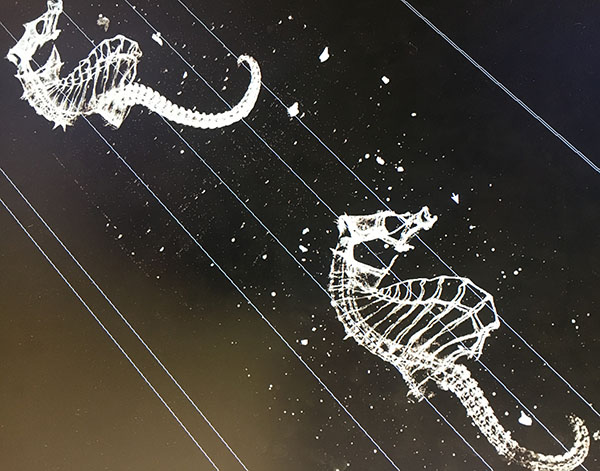 |
Fig. 8: Micro CT scan of H. japapigu. Photo credit: G. Short.
|
References:
Hamilton H, Saarman N, Short G, Sellas AB, Moore B, Hoang T, Grace CL, Gomon M, Crow K, and WB Simison. 2017. Molecular phylogeny and patterns of diversification in Syngnathid fishes. Molecular phylogenetics and Evolution: 107 (388-403). doi: 10.1016/j.ympev.2016.10.003
Lourie SA, Pollom RA, and SJ Foster. 2016. A global revision of the Seahorses Hippocampus Rafinesque 1810 (Actinopterygii: Syngnathiformes): Taxonomy and biogeography with recommendations for further research. Zootaxa: 4146 / 1 (1-66). doi: 10.11646/zootaxa.4146.1.1
Short G, Smith R, Motomura H, Harasti D, and H Hamilton. 2018. Hippocampus japapigu, a new species of pygmy seahorse from Japan, with a redescription of H. pontohi (Teleostei, Syngnathidae). ZooKeys: 779 (27-49). doi: 10.3897/zookeys.779.24799
|
|
© 2018 Friday Harbor Labs, 620 University Road, Friday Harbor WA 98250
|
|
|